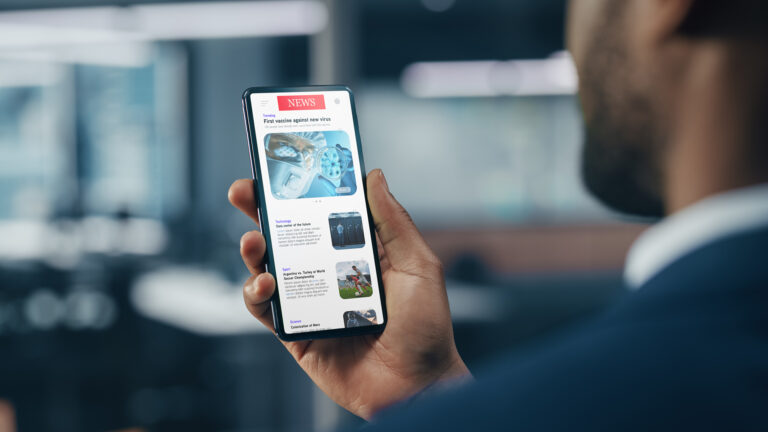Naomi Owusu, CEO of Tickaroo, talks about how the technology revolution has paved the way for smartphones and social media to become mainstream news outlets.
Technology continues to play a huge role in shaping our daily habits. With mobile phones controlling every aspect of our lives, it's no wonder that 39% of Brits look to their phones for the latest news. This trend is likely to increase further with the ever-growing technological revolution.
In fact, the average user spends almost four hours a day staring at a screen.
Media needs to adapt to new challenges
With the rise of the mobile revolution, 26% of 18-34 year olds now prefer short, bite-sized news updates. Kicker, Germany's top sports news provider, enjoys almost twice as many monthly viewers for its mobile coverage as its desktop coverage.
This creates new challenges for today's publishers and content creators, as they must adapt to evolving media habits to deliver accurate short-form content to their target audiences.
As the online environment becomes saturated with endless data, information, negative news, etc., users are facing sensory overload and digital dementia, and publishers need to cut through the noise to deliver the most relevant and urgent information. We are under pressure to deliver this to our viewers.
Additionally, as streams of online data increase, our attention spans are decreasing. 21% of readers spend less than 2 minutes reading an article.
As the technological revolution continues to reshape the media landscape, publishers need to think outside the box to identify ways to engage with and capture key audiences. Live blogging is emerging as an important tool for doing so, creating more customized and immersive content. experience for the audience.
The technological revolution has paved the way for social media as a news medium.
In a world dominated by smartphones, social media is becoming increasingly influential in shaping how we consume information and news.
Live blogs reflect the behaviors your audience learns as they scroll through social media platforms. Research reveals that social media continues to emerge as a major news source, with 21% of UK adults using social channels to get breaking news.
Today's consumers prefer bite-sized information that replicates the social media experience, making live blogging a popular format that offers the best of both worlds. Features hand-picked by trusted news providers allow viewers to receive news in a format that feels familiar but avoids harmful doomscrolling.
These highly curated, bite-sized news updates are much more manageable for our readers. Live blogs have the look and feel of social media, but with more control, broader views, and more power for editors.
The versatile live blog format also enables unique storytelling aspects, allowing publishers to embed a variety of elements such as text, video, graphics, polls, audio clips, and integrated social media posts. These features allow editorial teams to paint their own pictures beyond plain text and enable storytelling in a more curated way without sacrificing speed or accuracy.

This flexible format allows publishers to feature a wider range of events and articles, from fast-paced sporting events to useful travel content, from the latest election coverage to Taylor Swift's tour coverage.
Smartphones make news more accessible and interactive
Smartphones allow today's news readers to access news quickly and easily. Users can quickly get the most relevant and urgent updates without having to search through streams of additional information.
Readers are continuously provided with the latest critical understanding of the news that is relevant to them. For example, as the submarine Ocean Gate garners attention around the world, the New Zealand-based publisher's staff has released a live stream featuring chronological updates and insights from a variety of experts from the beginning of the event to its tragic conclusion. I ran a blog and provided readers with a comprehensive overview of information. Help your audience see the big picture.
Live blogging can address a variety of user needs by leveraging the need to connect, update, understand, and feel when consuming content.
This format allows you to embed interactive media such as polls, quizzes, and live comments into your publisher's live blog to encourage direct interaction with your readers. Responding and engaging with a variety of interactive content keeps readers entertained and feeling connected to your story and brand.
Live blogging allows publishers to leverage these common elements, allowing them to cater to more interactive audiences and creating significant opportunities for a deeper sense of community.
As the Women's World Cup heated up over the summer, Stuff's live blog covered matches and gave followers the chance to comment after important milestones like goals and wins. Other publishers are using these interactive features to collaborate with experts to discuss topics such as the cost of living crisis and the pandemic in his Q&A format. Readers can ask questions directly in the comments, and featured experts can directly answer viewer concerns.
Other publishers are using these interactive features to collaborate with experts to discuss topics like the cost of living crisis and the pandemic in a Q&A format. Readers can ask questions directly in the comments, and featured experts can directly answer viewer concerns.
Rapid technology revolution and the growing popularity of social media platforms are dramatically changing news consumption habits, forcing media companies to find innovative ways to keep consumers engaged. .
Live blogs and the unique visual and interactive features within the format help publishers position themselves as an engaging, understandable, and entertaining news source. Fully equipped to take advantage of today's mobile appeal while capturing the attention of today's readers.



